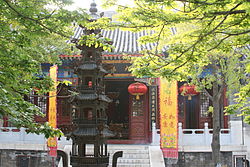Yunju Temple
| Yunju Temple | |
|---|---|

Guanyin Hall of the Yunju Temple
|
|
|
Location in Beijing municipality
|
|
| Basic information | |
| Geographic coordinates | 39°36′29″N 115°46′04″E / 39.60806°N 115.76778°ECoordinates: 39°36′29″N 115°46′04″E / 39.60806°N 115.76778°E |
| Affiliation | Buddhism |
| Country | China |
Yunju Temple (simplified Chinese: 云居寺; traditional Chinese: 雲居寺; pinyin: Yúnjū Sì) is a Buddhist temple located in Fangshan District, 70 kilometers southwest of Beijing.
The temple was first built in the early seventh century. In 616, the first Buddhist stone scripture tablet was made at the temple by a monk named Jingwan. Because there were debates going between Buddhists and Daoists, and Jingwan feared reprisals from Daoists, he decided to carve his scriptures on stone instead of writing them on paper. The work on the stone tablets continued on for more than a thousand years before ending in 1655. In the Sui dynasty and early Tang dynasty, twelve sutras were carved. In the Liao dynasty and Jin dynasty, the Khitan Tripitaka (契丹大藏經) was carved and this is the only one of this version of the Chinese Buddhist canon surviving today. Carved on 77,000 wooden blocks the scriptures attract a large number of visitors.
In total, 1,122 Buddhist scriptures in 3572 volumes were produced at the temple. In the 1930s, a significant portion of the temple was destroyed. Two bone fragments believed to belong to the Buddha are enshrined at the site.
There were originally six halls in the temple, arranged from east to west. On both sides of the halls, there was accommodation for guests and dormitories for monks.
The temple contains a total of twelve pagodas from the Tang and Liao dynasties and three tomb pagodas from the Qing dynasty.
...
Wikipedia

